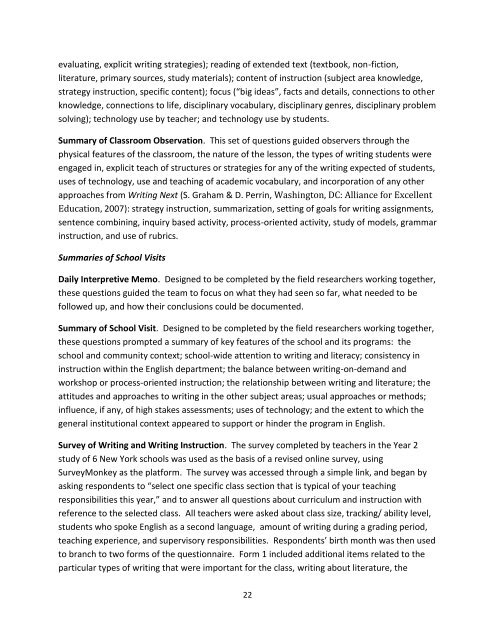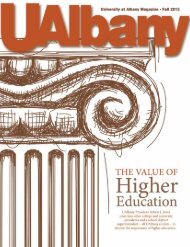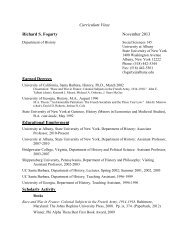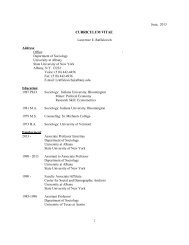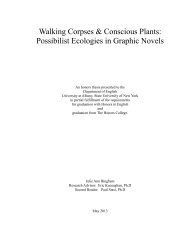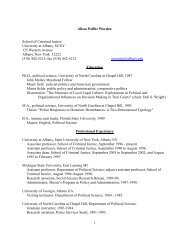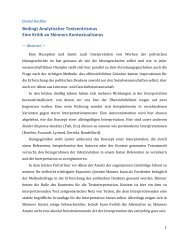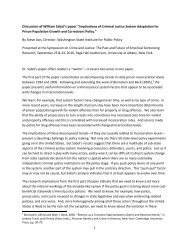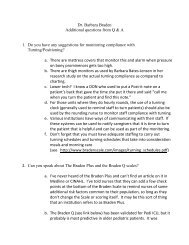The National Study of Writing Instruction - University at Albany
The National Study of Writing Instruction - University at Albany
The National Study of Writing Instruction - University at Albany
You also want an ePaper? Increase the reach of your titles
YUMPU automatically turns print PDFs into web optimized ePapers that Google loves.
evalu<strong>at</strong>ing, explicit writing str<strong>at</strong>egies); reading <strong>of</strong> extended text (textbook, non-fiction,<br />
liter<strong>at</strong>ure, primary sources, study m<strong>at</strong>erials); content <strong>of</strong> instruction (subject area knowledge,<br />
str<strong>at</strong>egy instruction, specific content); focus (“big ideas”, facts and details, connections to other<br />
knowledge, connections to life, disciplinary vocabulary, disciplinary genres, disciplinary problem<br />
solving); technology use by teacher; and technology use by students.<br />
Summary <strong>of</strong> Classroom Observ<strong>at</strong>ion. This set <strong>of</strong> questions guided observers through the<br />
physical fe<strong>at</strong>ures <strong>of</strong> the classroom, the n<strong>at</strong>ure <strong>of</strong> the lesson, the types <strong>of</strong> writing students were<br />
engaged in, explicit teach <strong>of</strong> structures or str<strong>at</strong>egies for any <strong>of</strong> the writing expected <strong>of</strong> students,<br />
uses <strong>of</strong> technology, use and teaching <strong>of</strong> academic vocabulary, and incorpor<strong>at</strong>ion <strong>of</strong> any other<br />
approaches from <strong>Writing</strong> Next (S. Graham & D. Perrin, Washington, DC: Alliance for Excellent<br />
Educ<strong>at</strong>ion, 2007): str<strong>at</strong>egy instruction, summariz<strong>at</strong>ion, setting <strong>of</strong> goals for writing assignments,<br />
sentence combining, inquiry based activity, process-oriented activity, study <strong>of</strong> models, grammar<br />
instruction, and use <strong>of</strong> rubrics.<br />
Summaries <strong>of</strong> School Visits<br />
Daily Interpretive Memo. Designed to be completed by the field researchers working together,<br />
these questions guided the team to focus on wh<strong>at</strong> they had seen so far, wh<strong>at</strong> needed to be<br />
followed up, and how their conclusions could be documented.<br />
Summary <strong>of</strong> School Visit. Designed to be completed by the field researchers working together,<br />
these questions prompted a summary <strong>of</strong> key fe<strong>at</strong>ures <strong>of</strong> the school and its programs: the<br />
school and community context; school-wide <strong>at</strong>tention to writing and literacy; consistency in<br />
instruction within the English department; the balance between writing-on-demand and<br />
workshop or process-oriented instruction; the rel<strong>at</strong>ionship between writing and liter<strong>at</strong>ure; the<br />
<strong>at</strong>titudes and approaches to writing in the other subject areas; usual approaches or methods;<br />
influence, if any, <strong>of</strong> high stakes assessments; uses <strong>of</strong> technology; and the extent to which the<br />
general institutional context appeared to support or hinder the program in English.<br />
Survey <strong>of</strong> <strong>Writing</strong> and <strong>Writing</strong> <strong>Instruction</strong>. <strong>The</strong> survey completed by teachers in the Year 2<br />
study <strong>of</strong> 6 New York schools was used as the basis <strong>of</strong> a revised online survey, using<br />
SurveyMonkey as the pl<strong>at</strong>form. <strong>The</strong> survey was accessed through a simple link, and began by<br />
asking respondents to “select one specific class section th<strong>at</strong> is typical <strong>of</strong> your teaching<br />
responsibilities this year,” and to answer all questions about curriculum and instruction with<br />
reference to the selected class. All teachers were asked about class size, tracking/ ability level,<br />
students who spoke English as a second language, amount <strong>of</strong> writing during a grading period,<br />
teaching experience, and supervisory responsibilities. Respondents’ birth month was then used<br />
to branch to two forms <strong>of</strong> the questionnaire. Form 1 included additional items rel<strong>at</strong>ed to the<br />
particular types <strong>of</strong> writing th<strong>at</strong> were important for the class, writing about liter<strong>at</strong>ure, the<br />
22


